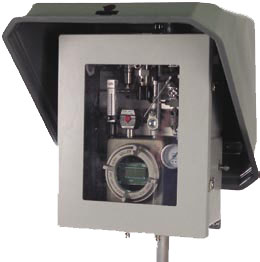Mission Critical Moisture Monitoring System for Gasses
 COSA’s Mission Critical Process Moisture Analyzer MODEL ESS-SCVP – Taking advantage of the uniquely strong and quasi-linear response characteristics of its HTF™ aluminum oxide moisture sensors, COSA has developed a cost effective solution for demanding and mission critical moisture monitoring applications.
COSA’s Mission Critical Process Moisture Analyzer MODEL ESS-SCVP – Taking advantage of the uniquely strong and quasi-linear response characteristics of its HTF™ aluminum oxide moisture sensors, COSA has developed a cost effective solution for demanding and mission critical moisture monitoring applications.
The system has an integrated, fully automatic self-calibration procedure, in which the sensor is periodically exposed to a NIST certified calibration gas and recalibrated. Thus, there can be a high (NIST traceable) confidence in the measurement. Sensors do not need to be returned to the factory for calibration.
This system has proven to produce consistently accurate monitoring results in natural gas and hydrocarbon processing applications, where conventional analyzers have failed.
Class I Div 1 Grps A, B, C, D, T4 and Class I Div 2 Grps A, B, C, D, T4
Mission-Critical Moisture Applications
In many applications, where control of moisture concentration has mission-critical character, industry has struggled with finding a stable, reliable and cost-effective measurement solution. Conventional sensors drift, vary with temperature or fall asleep; even when measuring clean inert gases. When measuring in the presence of contaminants or corrosive constituents, most measurements have failed completely or sensor life is prohibitively short.
Consequently, moisture measurements are used in most cases to provide a general indication only, but not for actual process control and if used for alarming, large safety margins are applied. Thus, large potential savings that could result from true process optimization based on a reliable moisture measurement, had to be foregone.
HTF™ moisture sensors have proven already to provide stable and reliable measurements in many applications where other technologies have failed. Now, with the Moisture Analyzer Model ESS-SCVP, COSA is offering a tool for true process control with integrated traceable field calibration and validation capabilities.
Sensor Calibration Using a Traceable Standard
Borrowing from a calibration procedure that is standard to many other process measurement technologies, COSA has developed a self-calibrating moisture system that periodically exposes the sensor to a NIST certified calibrating gas and automatically adjusts for observed deviations.
To perform the calibration procedure, a valve is included in the sample system, such that under the instrument’s control, the sensor can be switched from the process gas to a NIST traceable Nitrogen/Water blend bottle. The known water content of the bottle is pre-entered into the instrument’s memory together with a time schedule of verification/recalibration. The unattended instrument follows the schedule and performs the pre-programmed task of recalibrating. Thus the measurement near the water content of the bottle is essentially with NIST traceable accuracy even if the contaminants in the process gas have caused the sensing element to drift. As the measurements get further and further from the calibration point, the accuracy diminishes slightly but, because of COSA high capacitance sensor, the measurement can be easily kept within the specified tolerance of the instrument.
This method is particularly attractive for uses where there is an accepted alarm point, e.g. for Natural Gas – 7 pounds of water per million standard cubic feet (7 lbsH20/mmscf) – the calibration bottle can be ordered to contain the corresponding 143 parts per million by volume (ppmV) of water. When an alarm is generated, one can have an extremely high confidence in the measurement near that point, and suspicions can quickly be settled with a verification/recalibration against the traceable bottled standard.
- Advantages
- Applications
- Brochure
- High confidence in measurement
- Automatic Field-Calibration/Validation
- NIST Traceability
- Long Sensor Life
- Low Maintenance
- Low Installation Cost
- No Need for Factory Recalibrations
- Natural Gas
- Hydrocarbon Processing
- Catalyst Protection
- Heat Treating
- Industrial Gases
- Dryer Control